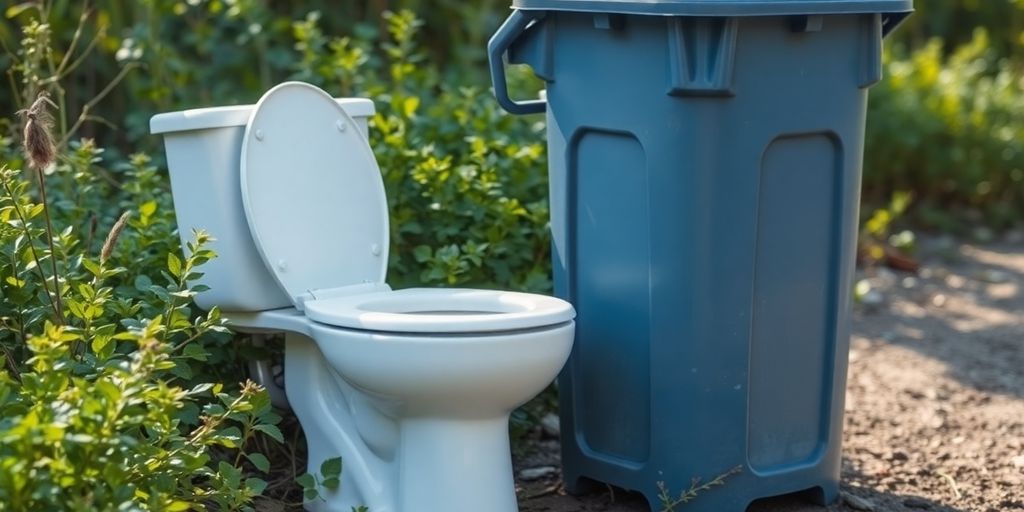Disposing of an old toilet properly is essential for protecting the environment and following local rules. This guide will help you understand the importance of responsible toilet disposal, how to prepare your toilet for disposal, and what options are available for getting rid of it safely and sustainably.
- Discover the Hidden Gems: The Best Open Gardens Near Me in Seattle
- Discover the Best Veg and Non Veg Hotel Near Me for an Unforgettable Dining Experience
- Discover the Best Veg Buffet Near Me: A Culinary Adventure Awaits!
- Discover Who Sells Amazon Gift Cards Near Me: Your Ultimate Guide to Local Retailers
- Discover the Top Biryani Centre Near Me for an Unforgettable Culinary Experience
Key Takeaways
- Always disconnect the toilet safely before disposal.
- Consider recycling or donating your old toilet if it’s still usable.
- Check local guidelines for curbside collection or disposal options.
- Transport your toilet securely to prevent accidents.
- Choose a water-efficient model when replacing your old toilet.
Understanding the Importance of Responsible Toilet Disposal
Toilets are often made from materials that can last for hundreds of years in landfills, making responsible disposal crucial. Improper disposal can lead to pollution and waste of valuable resources. Here’s why it matters:
You are viewing: Where to Take Old Toilets Near Me: A Comprehensive Guide to Responsible Disposal
Environmental Impact of Improper Disposal
- Toilets contain non-biodegradable materials like porcelain.
- They can contribute to landfill overflow.
- Pollutants from toilets can seep into the ground and water sources.
Benefits of Recycling and Reusing Toilets
- Conserves resources by reusing materials.
- Reduces the need for new raw materials.
- Supports local recycling programs, which can create jobs.
Legal and Community Guidelines
- Many areas have specific rules for toilet disposal.
- Not following these rules can lead to fines.
- Always check local regulations before disposing of your toilet.
Responsible toilet disposal not only protects the environment but also helps communities thrive. By recycling or donating, we can make a positive impact on our surroundings.
In summary, understanding the importance of responsible toilet disposal is essential for protecting our environment and adhering to community standards. Make sure to follow local guidelines to ensure a safe and eco-friendly disposal process.
Steps to Prepare Your Old Toilet for Disposal
Disconnecting the Toilet Safely
To start, you need to disconnect the toilet from the plumbing. Here’s how:
- Turn off the water supply by locating the valve behind the toilet and turning it clockwise.
- Remove the tank lid and flush the toilet to empty the tank. Use a sponge to soak up any remaining water.
- Disconnect the water supply line using an adjustable wrench, keeping a towel handy for any spills.
- Loosen and remove the toilet bolts at the base with a wrench. If they’re stuck, a little penetrating oil can help.
Cleaning and Draining the Toilet
Once disconnected, it’s time to prepare the toilet for disposal:
- Drain the toilet completely to avoid spills. Use a plunger to push out as much water as possible, then scoop out the rest with a sponge or cup.
- Clean the toilet with a disinfectant cleaner. Scrub the inside thoroughly, especially under the rim, and wipe down the outside with a disposable cloth.
- Allow the cleaner to sit for a few minutes to kill germs and break down any stains.
Removing Non-Recyclable Components
Before disposal, you need to take off any parts that can’t be recycled:
- Unscrew the toilet seat from the bowl using a standard screwdriver.
- Remove the flush handle and any internal mechanisms from the tank. Be careful, as some nuts may be reverse-threaded.
- Check for any plastic or metal parts inside the tank and remove them as well.
Remember, preparing your toilet properly helps in responsible disposal and reduces environmental impact.
By following these steps, you can ensure that your old toilet is ready for its next journey, whether it’s recycling, donation, or disposal. Disposing of a toilet doesn’t have to be complicated; just take it step by step!
Exploring Disposal Options for Old Toilets
When it comes to getting rid of your old toilet, there are several responsible options to consider. Choosing the right disposal method can help protect the environment. Here are some common ways to dispose of your old toilet:
Curbside Collection Services
- Many cities offer curbside collection for bulk waste, including toilets.
- Check with your local waste management to find out the specific guidelines for disposal.
- Make sure to remove the tank lid and seat, and ensure there’s no water left in the bowl.
Recycling Centers and Facilities
- Some areas have recycling programs that accept porcelain toilets.
- Even if your city doesn’t recycle toilets, parts like fasteners and the toilet seat may still be recyclable.
- Contact your local recycling center to see what options are available.
Donating to Charitable Organizations
- If your toilet is still in good condition, consider donating it to a charity.
- Organizations like Habitat for Humanity may accept toilets, but it’s best to call ahead to confirm.
- Ensure the toilet is clean and functional before donating.
Remember, toilets may be put in the garbage. Check with your waste hauler or see landfills and transfer stations for drop-off options.
Transporting Your Old Toilet Safely
Read More : Discover the Ultimate Lounge Bar Near Me: A Guide to the Best Local Spots
When it comes to moving your old toilet, safety is key. Here are some important steps to follow:
Securing the Toilet for Transport
- Use a dolly or hand truck to help move the toilet.
- Carefully tilt the toilet to the side and slide the dolly underneath.
- Make sure the toilet is secured with straps to prevent it from shifting during transport.
Local Regulations and Guidelines
- Check local laws regarding transporting toilets. Some areas have specific rules.
- Ensure you know the operating hours and any fees at disposal sites.
- Be aware of any requirements for preparing the toilet for disposal, such as breaking it down into smaller pieces.
Hiring Professional Services
- If the toilet is too heavy or awkward, consider hiring a junk removal service.
- Professionals can ensure safe transport and proper disposal.
- This option can save you time and reduce the risk of injury.
Always lift with your legs, not your back, to avoid injury. Proper preparation and care can make the process smoother and safer.
Creative Ways to Repurpose or Upcycle Old Toilets
Repurposing your old toilet can be a fun and eco-friendly way to give it a new life. Here are some creative ideas:
Using Toilets as Garden Planters
- Planter Bowl: The toilet bowl can be transformed into a unique planter. Fill it with soil and your favorite flowers or herbs. You can even paint it to match your garden style.
- Tank Lid Birdbath: The tank lid can serve as a charming birdbath. Just add some water and watch the birds enjoy!
- Decorative Features: Consider using the toilet as a quirky garden decoration, adding character to your outdoor space.
Creating Art Pieces from Toilet Parts
- Mosaic Art: Use pieces of the porcelain to create beautiful mosaic art. This can be a fun project for artists looking to use recycled materials.
- Sculptures: Transform the toilet into a sculpture. With some creativity, it can become a statement piece in your yard or home.
- Functional Art: Combine art with function by making items like stools or tables from the toilet parts.
Other Innovative Upcycling Ideas
- Outdoor Seating: Turn the toilet into a unique outdoor seat. Just add some cushions for comfort.
- Storage Solutions: Use the tank for storage, like keeping gardening tools or other small items.
- Playground Equipment: If you have kids, consider using the toilet as part of a play area, like a sandbox or a fun climbing structure.
Upcycling is not just about saving the environment; it’s also about unleashing your creativity. Think outside the box and have fun with your old toilet!
Choosing an Eco-Friendly Replacement Toilet
After you’ve responsibly disposed of your old toilet, it’s time to think about a new one that’s better for the environment. Choosing a water-efficient model can save you money on your water bill and help conserve water. Here are some key points to consider:
Water-Efficient Models
- Dual Flush Toilets: These toilets offer two flush options, allowing you to use less water for liquid waste.
- Low-Flow Toilets: These use 1.6 gallons or less per flush, compared to older models that can use up to 5 gallons.
- High-Efficiency Toilets (HETs): These advanced toilets use about 1.28 gallons per flush or less, making them very efficient.
- Composting Toilets: These use little to no water and turn waste into compost, but they may need more maintenance.
Sustainable Manufacturing Practices
When selecting a new toilet, look for:
- Efficiency Ratings: Choose models with the EPA’s WaterSense label to ensure they meet strict water usage standards.
- Material and Durability: A sturdy toilet lasts longer, reducing the need for future replacements.
- Eco-Friendly Manufacturing: Research the company’s practices to see if they use sustainable materials.
Proper Installation Techniques
- Sealing and Fitting: Make sure the toilet is properly sealed to prevent leaks.
- Tool Efficiency: Use manual tools when possible to save energy during installation.
Choosing an eco-friendly toilet not only benefits the environment but also enhances your bathroom’s efficiency. Consider your options carefully to make a positive impact!
Documenting and Finalizing the Disposal Process
When you dispose of your old toilet, it’s important to keep track of the process. This helps ensure you follow local rules and regulations. Here are some steps to consider:
Keeping Records of Disposal
- Take photos of the toilet before and after disposal.
- Keep receipts from recycling centers or landfills.
- Document any communications with local authorities regarding disposal.
Notifying Local Authorities if Required
In some areas, you may need to inform local waste management about your disposal plans. Here’s what to do:
- Check local regulations to see if notification is necessary.
- Contact your waste management authority to report your disposal.
- Follow any specific instructions they provide.
Ensuring Compliance with Regulations
Read More : Discover the Best Live Orchestra Bar Near Me for an Unforgettable Night Out
Make sure you follow all local guidelines to avoid fines or issues:
- Review the disposal process outlined in local laws, such as 40 CFR Part 705.
- Prepare the toilet according to the requirements of the disposal facility.
- Transport the toilet safely to the designated location.
Keeping thorough records of your disposal process not only helps you stay compliant but also contributes to responsible waste management in your community.
Final Thoughts on Toilet Disposal
In conclusion, disposing of an old toilet doesn’t have to be a hassle. By following the right steps, you can make sure it’s done safely and responsibly. Whether you choose to recycle, donate, or throw it away, each option helps keep our environment clean. Remember, it’s not just about getting rid of the toilet; it’s about making smart choices that benefit our planet. If you need help, don’t hesitate to reach out to local services that specialize in junk removal. Together, we can ensure that our waste is handled in a way that protects our community and the environment.
Frequently Asked Questions
What should I do before getting rid of my old toilet?
Before disposing of your old toilet, make sure to disconnect it from the plumbing, clean it, and remove any non-recyclable parts.
Can I recycle my toilet?
Yes, in some places, you can recycle toilets. Check with your local recycling center to see if they accept porcelain.
How can I donate my old toilet?
If your toilet is still in good shape, contact local charities to see if they accept donations of bathroom fixtures.
What are the signs that my toilet needs to be replaced?
Look for signs like frequent clogs, leaks, cracks, or if it uses too much water.
Is it safe to transport a toilet by myself?
If the toilet is heavy, it’s best to get help. Make sure to secure it well in your vehicle.
What is the average lifespan of a toilet?
Toilets can last over 50 years, but parts may need to be replaced more often.
Soure: https://herego.net
Category: near me


